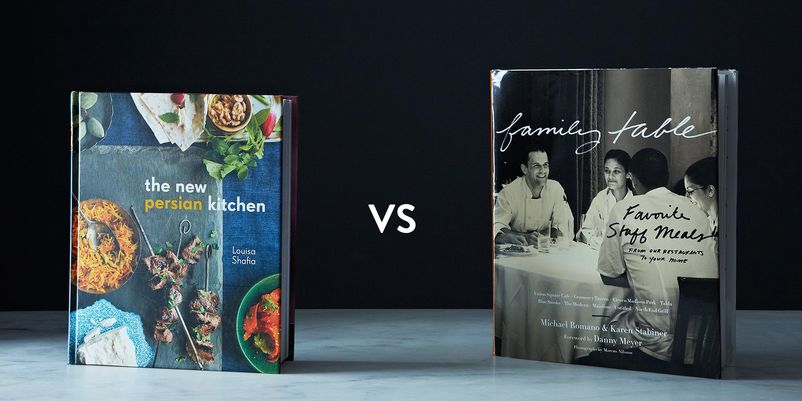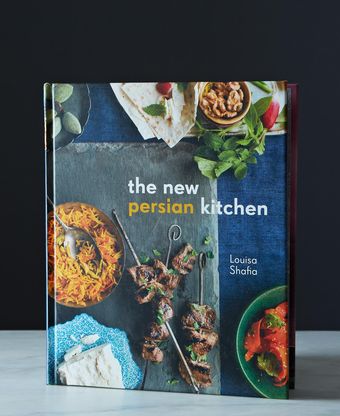I’m no stranger to competition, but when two packages arrive, each containing cookbooks that are to be pitted against each other, even I take a moment to process. Normally I add cookbooks to my collection or I don't. This time, I'm to thoroughly read both, cook a meal from each, and choose a winner.
I turn to package one: Family Table.
Conceptually this is great book. It’s all about extended family meals; it’s not overly fancy or complicated, but rather it’s full of what chefs make for each other -- and for their staff, or “families” -- when they eat together. It gives a behind-the-scenes glance at what it’s like to run a restaurant, and of what goes on in the kitchen.
The look of the book is moody, with candid photos in black and white and food photos taken with dark, stark backgrounds. Chefs grace the front cover -- a first impression that might prove intimidating to some novice cooks.
But it’s not, really: The recipes are primarily filled with ingredients that are probably already in your average home cook’s lexicon (or perhaps pantry), and they have fairly simple preparations. When recipes do require a slightly longer time commitment, most often that means hands-off cooking time. And for those items not already in my pantry, there’s an in-depth section to turn to, full of information on unusual beans and grains. It's a compelling look at ingredients a lot of cookbooks seem to gloss over.
The table of contents gave me pause, though. Flip a few pages into the book, and you get only categories rather than the dishes themselves. As someone who likes to get a sense of the scope of the book before I dive in, I would have appreciated not having to browse an entire section to find a particular recipe.
I browsed on, and made the Braised Red Cabbage with Roasted Pears, which required a long stove-top simmer of cabbage and onions with apple juice and white wine. But while the photo in the book looked perfectly slouchy, slack in all the right places, my cabbage retained a bit of crunch, even after I simmered it for an hour as the recipe directed. Simmered longer, it began to relax, and became the dish I hoped it would be. The next day it was even better. It’d be perfect made ahead of time for a dinner party, I thought, along with the next recipe I tested: Cola-Braised Short Ribs.
They required 2 1/2 hours to cook, but I didn’t mind the time investment. (Something you might not know about me: I’m a bit of a braiseaholic.) After their long stint in the oven, the short ribs were good -- tender and savory, just as they should be. But again I couldn’t get my dish to look much like the picture in the book, and this time it was the braising liquid’s fault. In the photo it was thick and syrupy; in my bowl it was thin and a little anemic, even after I tried reducing it for longer than the recipe suggested. I wondered, after having problems with my first two recipes, how many times they were tested.
Family Table’s Roasted Cauliflower with Lemon-Caper Dressing changed my mind. It was simple and came together quickly, and the dressing -- made of lemon juice, capers, egg yolk, and vegetable oil -- was the perfect, tart foil for the cauliflower. This dish will be a go-to side for me from now on.
Package two is up next, and I open it knowing that my last impression of Family Table would be hard to beat.
On first glance, the best way to describe The New Persian Kitchen by Louisa Shafia is fun. Visually, it’s very pleasing; as I flipped through, I found myself loving the layout, the bright colors, the photos. Each made the recipes -- filled with different flavors and textures -- that much more appealing. I felt compelled to try something new.
But before I could, I had to track down some of the unusual ingredients the book calls for, which proved to be difficult. Even after a trip to a specialty store, some of the Persian ingredients were too hard to find. But hunting for new and interesting ingredients is not without its merits or rewards, and if it’s something you enjoy, then this is a book for you.
Once I gathered my ingredients, I made Parvin’s Tamarind Stuffed Fish. Its recipe was easy to follow, and when it came out of the oven, it was absolutely beautiful -- something I could picture being a centerpiece dish at a party. The barberries, ground almonds, tamarind, and fresh minced herbs made the dish wonderfully fragrant and colorful. I made a note to remind myself to cook this again.
As you go through the book, you get much more than the recipes. Peppered throughout is a lot of interesting information -- from three different methods for juicing pomegranates to the difference between Persian and Iranian restaurants. Pass a few more recipes and you’ll find tips for preparing whole grains, then a guide to Persian ingredients. Pass more still, and you’ll learn how make some of her dishes vegetarian-friendly.
Louisa’s Roasted Stuffed Artichokes with Mint Oil were next. I dutifully stuffed each artichoke with ricotta, saffron, and lemon zest, and drizzled them all with lemon juice and mint oil before roasting. The recipe was clear, the preparation simple, and the resulting dish -- just like the last -- tasted complex, fragrant, and like it had taken much more work to make than it actually had.
In the introduction, Louisa explains that her aim is to blend the foreign and the familiar, with a focus on fresh food and healthful cooking. That is exactly what she does, and it makes the book one of the most refreshing I’ve cooked from in a while.
The New Persian Kitchen emphasizes whole grains and new flours and uses spice over fat, and does it all without being overly virtuous. Her food is new, it’s fun, and though I’m glad to have both of these books in my library, I’ll turn to Louisa more often for her fresh perspective. I know she’ll be the one to, more reliably, stretch the boundaries of my taste buds.
For me, The New Persian Kitchen takes this round.



56 Comments
The New Persian Kitchen, too, is on my wishlist. I had a lot of friends from Iran during the time I was at Uni and ate a lot of amazing foods. Haven't thought about that in years, but now I can revisit those meals. Excellent review because I actually am interested in the layout and photographs as well as the recipes. Covered it all! ;)